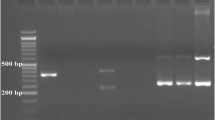Abstract
Routine detection of extended-spectrum β-lactamase (ESBL) production by AmpC-producing Enterobacteriaceae in microbiology laboratories is still a problem. The aim of this study was to compare the performance of four different phenotypic ESBL confirmation assays within this group of Enterobacteriaceae. A total of 83 AmpC-inducible Enterobacteriaceae were included in this study (58 clinical isolates with presumptive ESBL production and 25 molecularly characterized ESBL-producing isolates). Each isolate was tested for the presence of an ESBL enzyme by four phenotypic ESBL confirmation assays: ESBL Etests® and combined double-disk synergy tests (CDDST), both on Mueller–Hinton (MH) agar with and without the use of cloxacillin, an AmpC inhibitor. Our study showed that performing a CDDST on MH agar with cefotaxime as the only indicator cephalosporin is not a reliable way to detect ESBL-encoding genes among chromosomal AmpC-producing Enterobacteriaceae due to its low sensitivity (52 %). The use of cloxacillin in this CDDST could only significantly increase the specificity of the CDDST when used with ceftazidime as the indicator [sensitivity (SN), 92 %; specificity (SP), 93 %]. Regarding ESBL Etest® strips, the sensitivity of the cefepime strip (80 %) was significantly higher compared to the cefotaxime and ceftazidime strips (16 % and 32 %, respectively). Adding cloxacillin to the MH agar improved the ESBL detection of each of these strips. We recommend the CDDST on MH agar supplemented with cloxacillin and ceftazidime or cefepime as the indicator cephalosporin as the most cost-efficient strategy to confirm ESBL production in inducible AmpC-producing Enterobacteriaceae.
Similar content being viewed by others
References
[No authors listed] (2002) The cost of antibiotic resistance: effect of resistance among Staphylococcus aureus, Klebsiella pneumoniae, Acinetobacter baumannii, and Pseudomonas aeruginosa on length of hospital stay. Infect Control Hosp Epidemiol 23:106–108
Lautenbach E, Patel JB, Bilker WB, Edelstein PH, Fishman NO (2001) Extended-spectrum β-lactamase-producing Escherichia coli and Klebsiella pneumoniae: risk factors for infection and impact of resistance on outcomes. Clin Infect Dis 32:1162–1171
Cantón R, Coque TM (2006) The CTX-M beta-lactamase pandemic. Curr Opin Microbiol 9(5):466–475
Pfaller MA, Segreti J (2006) Overview of the epidemiological profile and laboratory detection of extended-spectrum beta-lactamases. Clin Infect Dis 42(Suppl 4):S153–S163
Ramphal R, Ambrose PG (2006) Extended-spectrum beta-lactamases and clinical outcomes: current data. Clin Infect Dis 42(Suppl 4):S164–S172
Garrec H, Drieux-Rouzet L, Golmard JL, Jarlier V, Robert J (2011) Comparison of nine phenotypic methods for detection of extended-spectrum β-lactamase production by Enterobacteriaceae. J Clin Microbiol 49(3):1048–1057
Wiegand I, Geiss HK, Mack D, Stürenburg E, Seifert H (2007) Detection of extended-spectrum beta-lactamases among Enterobacteriaceae by use of semiautomated microbiology systems and manual detection procedures. J Clin Microbiol 45:1167–1174
Harada S, Ishii Y, Yamaguchi K (2008) Extended-spectrum β-lactamases: implications for the clinical laboratory and therapy. Korean J Lab Med 28:401–412
Jiang X, Zhang Z, Li M, Zhou D, Ruan F, Lu Y (2006) Detection of extended-spectrum β-lactamases in clinical isolates of Pseudomonas aeruginosa. Antimicrob Agents Chemother 50(9):2990–2995
Tzelepi E, Giakkoupi P, Sofianou D, Loukova V, Kemeroglou A, Tsakris A (2000) Detection of extended-spectrum beta-lactamases in clinical isolates of Enterobacter cloacae and Enterobacter aerogenes. J Clin Microbiol 38(2):542–546
Drieux L, Brossier F, Sougakoff W, Jarlier V (2008) Phenotypic detection of extended-spectrum beta-lactamase production in Enterobacteriaceae: review and bench guide. European Society of Clinical Microbiology and Infectious Diseases. J Clin Microbiol Infect 14(Suppl 1):90–103
Towne TG, Lewis JS 2nd, Herrera M, Wickes B, Jorgensen JH (2010) Detection of SHV-type extended-spectrum beta-lactamase in Enterobacter isolates. J Clin Microbiol 48(1):298–299
Stürenburg E, Sobottka I, Noor D, Laufs R, Mack D (2004) Evaluation of a new cefepime–clavulanate ESBL Etest to detect extended-spectrum beta-lactamases in an Enterobacteriaceae strain collection. J Antimicrob Chemother 54(1):134–138
Mohanty S, Gaind R, Ranjan R, Deb M (2009) Use of the cefepime–clavulanate ESBL Etest for detection of extended-spectrum beta-lactamases in AmpC co-producing bacteria. J Infect Dev Ctries 4(1):24–29
Stuart JC, Diederen B, Al Naiemi N, Fluit A, Arents N, Thijsen S, Vlaminckx B, Mouton JW, Leverstein-van Hall M (2011) Method for phenotypic detection of extended-spectrum beta-lactamases in Enterobacter species in the routine clinical setting. J Clin Microbiol 49(7):2711–2713
Clinical and Laboratory Standards Institute (CLSI) (2011) Performance standards for antimicrobial susceptibility testing; Twenty-first informational supplement. CLSI document M100-S21. CLSI, Wayne
Check-MDR CT101. User manual, version 1.1, issued October 1, 2010. Check-Points Health BV, Wageningen, the Netherlands
Acknowledgments
We thank the team of the laboratory of molecular biology of Jessa Hospital, Hasselt, Belgium, for their assistance in this study.
Conflict of interest
This study was sponsored by the manufacturer of the Neo-Sensitabs® (Rosco Diagnostica, Taastrup, Denmark) and by the manufacturer of the MH agars containing cloxacillin (AES Chemunex, Bruz, France).
Author information
Authors and Affiliations
Corresponding author
Rights and permissions
About this article
Cite this article
Willems, E., Cartuyvels, R., Magerman, K. et al. Comparison of different phenotypic assays for the detection of extended-spectrum β-lactamase production by inducible AmpC-producing Gram-negative bacilli. Eur J Clin Microbiol Infect Dis 32, 549–555 (2013). https://doi.org/10.1007/s10096-012-1772-x
Received:
Accepted:
Published:
Issue Date:
DOI: https://doi.org/10.1007/s10096-012-1772-x




